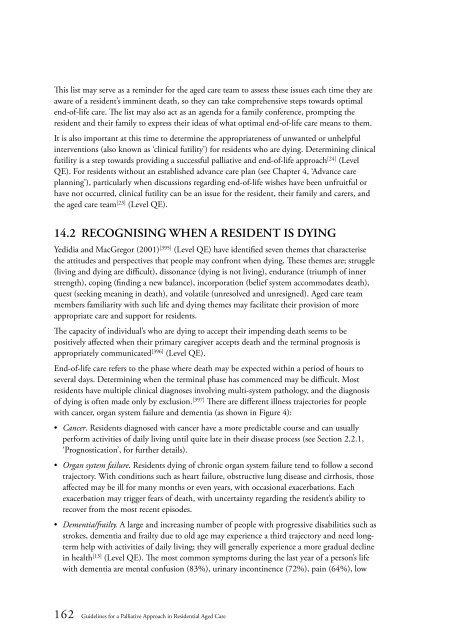Guidelines for a Palliative Approach in Residential Aged Care
Guidelines for a Palliative Approach in Residential Aged Care
Guidelines for a Palliative Approach in Residential Aged Care
Create successful ePaper yourself
Turn your PDF publications into a flip-book with our unique Google optimized e-Paper software.
This list may serve as a rem<strong>in</strong>der <strong>for</strong> the aged care team to assess these issues each time they are<br />
aware of a resident’s imm<strong>in</strong>ent death, so they can take comprehensive steps towards optimal<br />
end-of-life care. The list may also act as an agenda <strong>for</strong> a family conference, prompt<strong>in</strong>g the<br />
resident and their family to express their ideas of what optimal end-of-life care means to them.<br />
It is also important at this time to determ<strong>in</strong>e the appropriateness of unwanted or unhelpful<br />
<strong>in</strong>terventions (also known as ‘cl<strong>in</strong>ical futility’) <strong>for</strong> residents who are dy<strong>in</strong>g. Determ<strong>in</strong><strong>in</strong>g cl<strong>in</strong>ical<br />
futility is a step towards provid<strong>in</strong>g a successful palliative and end-of-life approach [24] (Level<br />
QE). For residents without an established advance care plan (see Chapter 4, ‘Advance care<br />
plann<strong>in</strong>g’), particularly when discussions regard<strong>in</strong>g end-of-life wishes have been unfruitful or<br />
have not occurred, cl<strong>in</strong>ical futility can be an issue <strong>for</strong> the resident, their family and carers, and<br />
the aged care team [23] (Level QE).<br />
14.2 RECOGNISING WHEN A RESIDENT IS DYING<br />
Yedidia and MacGregor (2001) [395] (Level QE) have identified seven themes that characterise<br />
the attitudes and perspectives that people may confront when dy<strong>in</strong>g. These themes are; struggle<br />
(liv<strong>in</strong>g and dy<strong>in</strong>g are difficult), dissonance (dy<strong>in</strong>g is not liv<strong>in</strong>g), endurance (triumph of <strong>in</strong>ner<br />
strength), cop<strong>in</strong>g (f<strong>in</strong>d<strong>in</strong>g a new balance), <strong>in</strong>corporation (belief system accommodates death),<br />
quest (seek<strong>in</strong>g mean<strong>in</strong>g <strong>in</strong> death), and volatile (unresolved and unresigned). <strong>Aged</strong> care team<br />
members familiarity with such life and dy<strong>in</strong>g themes may facilitate their provision of more<br />
appropriate care and support <strong>for</strong> residents.<br />
The capacity of <strong>in</strong>dividual’s who are dy<strong>in</strong>g to accept their impend<strong>in</strong>g death seems to be<br />
positively affected when their primary caregiver accepts death and the term<strong>in</strong>al prognosis is<br />
appropriately communicated [396] (Level QE).<br />
End-of-life care refers to the phase where death may be expected with<strong>in</strong> a period of hours to<br />
several days. Determ<strong>in</strong><strong>in</strong>g when the term<strong>in</strong>al phase has commenced may be difficult. Most<br />
residents have multiple cl<strong>in</strong>ical diagnoses <strong>in</strong>volv<strong>in</strong>g multi-system pathology, and the diagnosis<br />
of dy<strong>in</strong>g is often made only by exclusion. [397] There are different illness trajectories <strong>for</strong> people<br />
with cancer, organ system failure and dementia (as shown <strong>in</strong> Figure 4):<br />
• Cancer. Residents diagnosed with cancer have a more predictable course and can usually<br />
per<strong>for</strong>m activities of daily liv<strong>in</strong>g until quite late <strong>in</strong> their disease process (see Section 2.2.1,<br />
‘Prognostication’, <strong>for</strong> further details).<br />
• Organ system failure. Residents dy<strong>in</strong>g of chronic organ system failure tend to follow a second<br />
trajectory. With conditions such as heart failure, obstructive lung disease and cirrhosis, those<br />
affected may be ill <strong>for</strong> many months or even years, with occasional exacerbations. Each<br />
exacerbation may trigger fears of death, with uncerta<strong>in</strong>ty regard<strong>in</strong>g the resident’s ability to<br />
recover from the most recent episodes.<br />
• Dementia/frailty. A large and <strong>in</strong>creas<strong>in</strong>g number of people with progressive disabilities such as<br />
strokes, dementia and frailty due to old age may experience a third trajectory and need longterm<br />
help with activities of daily liv<strong>in</strong>g; they will generally experience a more gradual decl<strong>in</strong>e<br />
<strong>in</strong> health [13] (Level QE). The most common symptoms dur<strong>in</strong>g the last year of a person’s life<br />
with dementia are mental confusion (83%), ur<strong>in</strong>ary <strong>in</strong>cont<strong>in</strong>ence (72%), pa<strong>in</strong> (64%), low<br />
162 <strong>Guidel<strong>in</strong>es</strong> <strong>for</strong> a <strong>Palliative</strong> <strong>Approach</strong> <strong>in</strong> <strong>Residential</strong> <strong>Aged</strong> <strong>Care</strong>
















